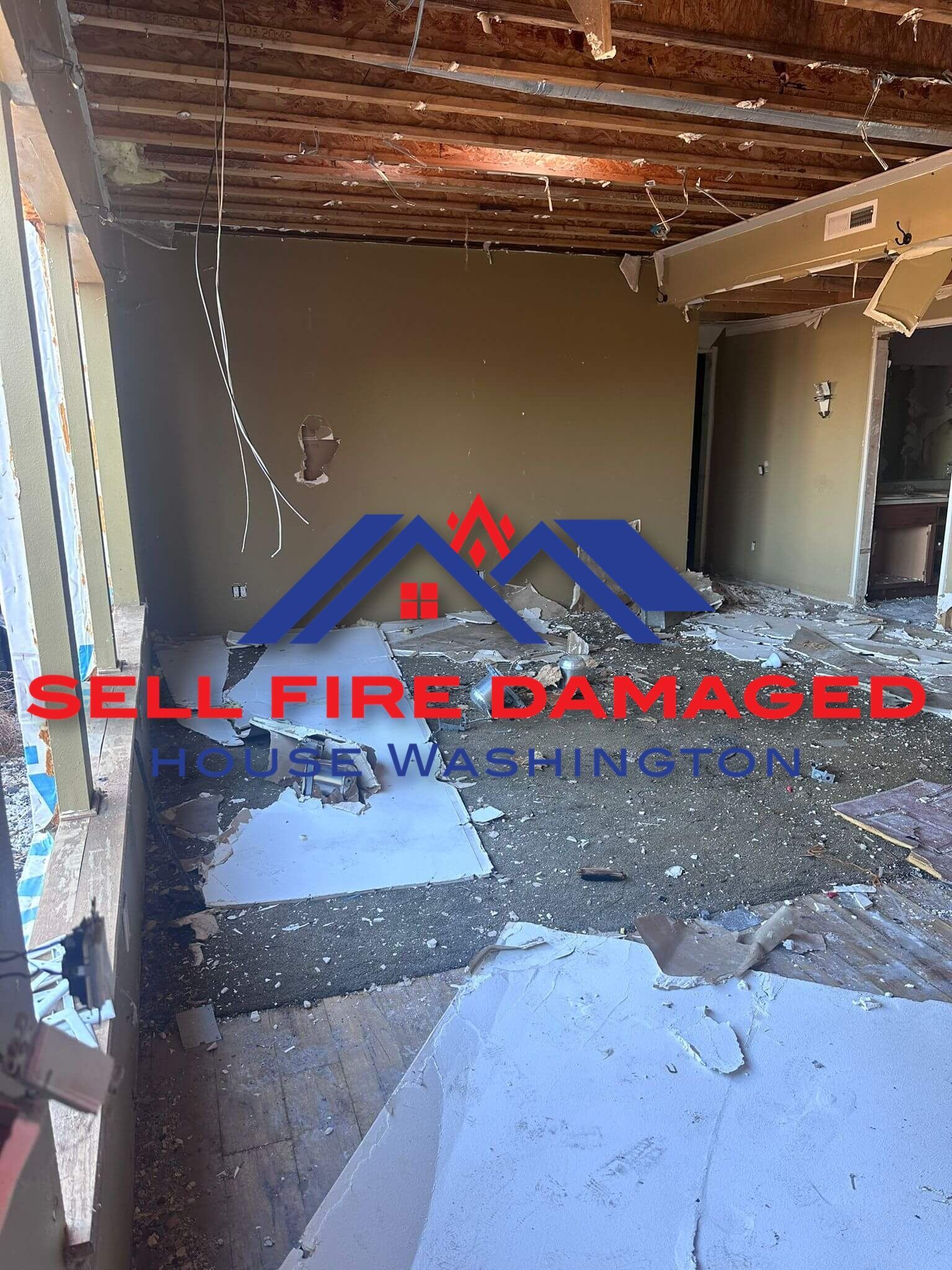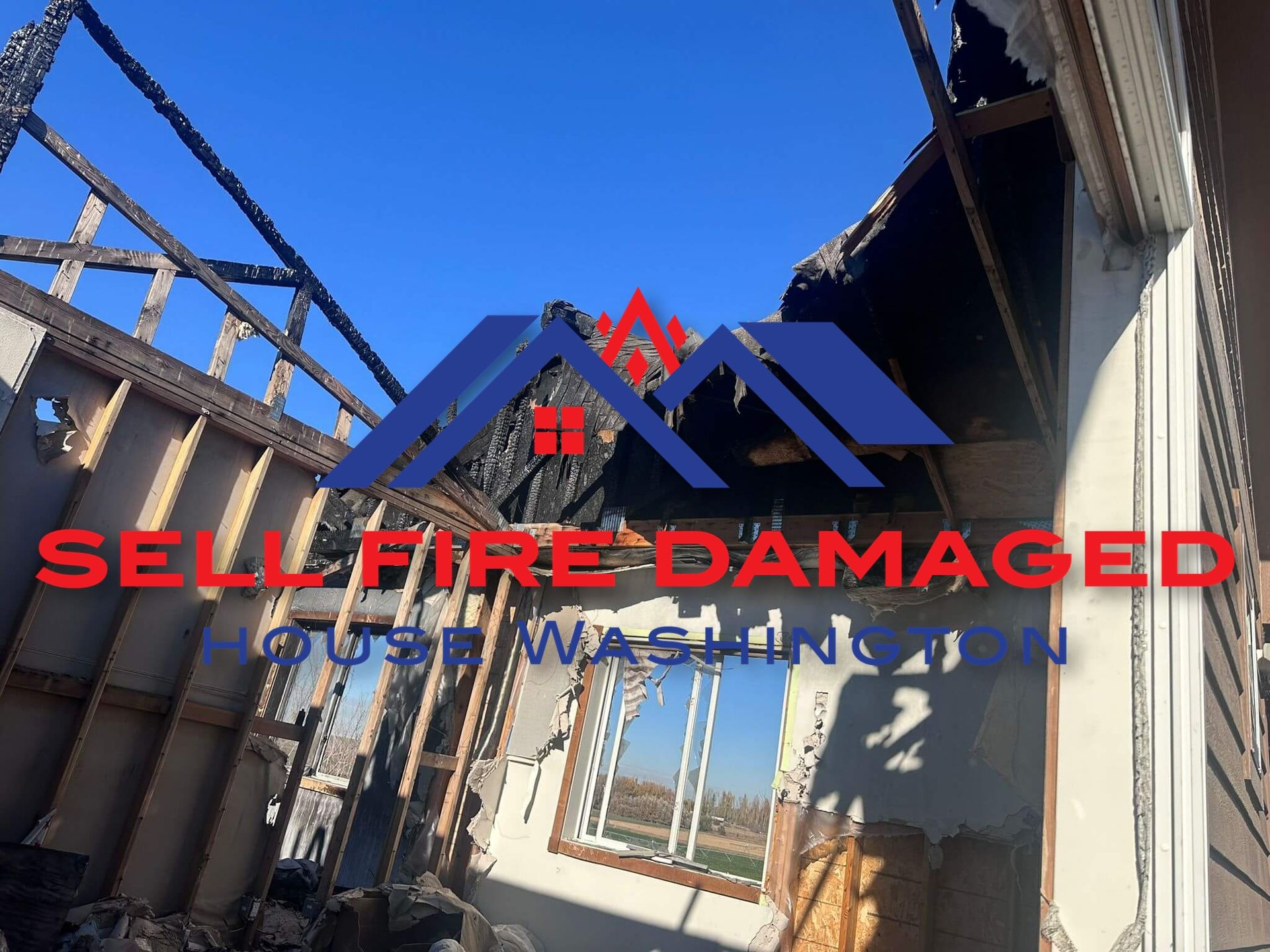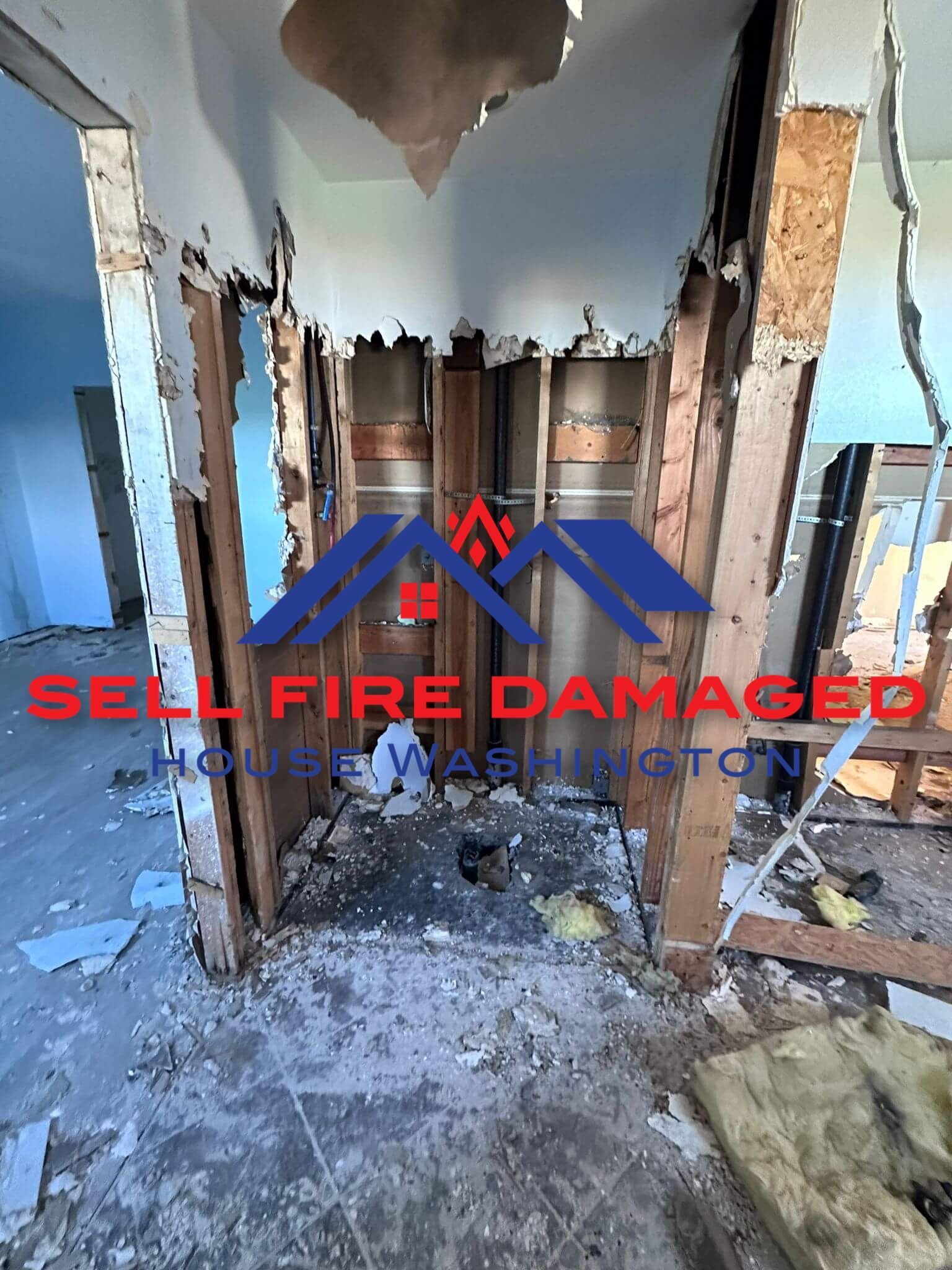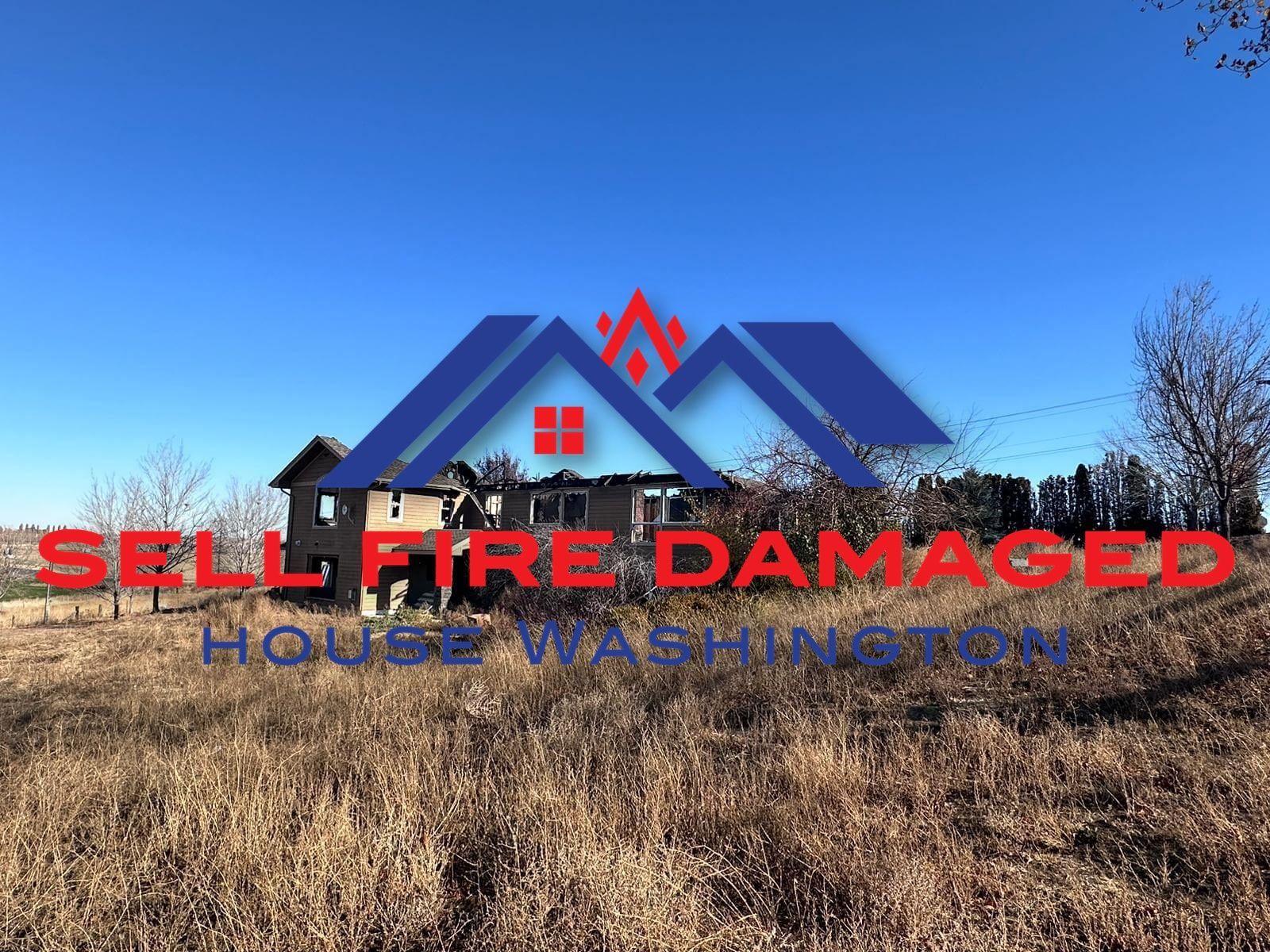How To Properly Price A Fire-Damaged House In Washington
Published on December 22nd, 2024
Free Offer Form
We will get back to you as soon as possible.
Please try again later.
Any property damage from house fires can greatly affect lives and finances.
With an average fire damage restoration cost of up to $40,000 and fire damage cleanup costs reaching $6.50 per square foot, selling a house after a fire is a popular option.
Multiple factors can change a house's pricing. The severity of the fire damage, the age and condition of the home, and its location all play a part in fire damage restoration costs.
Severe house fire damage leads to higher expenses for fire damage restoration. This guide will break down different elements affecting how to price a fire-damaged house and cost-effective ways to market the property.
Understanding the Impact of Fire Damage on Property Value In Washington
House fires can have different causes. Whether it's from a grease fire or an electrical issue, the connection between a house fire and property depreciation lies in the severity of the damage.
More severe fire damage results in a higher fire restoration cost estimate, decreasing its value.
Fire damage restoration companies separate house fires into categories rising in severity. For example, class A fires involve solid materials that burn due to a nearby heat source.
Meanwhile, a class C fire from flammable gases is more dangerous. It typically causes major structural damage.
The severity of the damage directly affects the property value. Devastating house fires require more structural repairs. Charred walls, strong smoke odors, and chemical residue can affect the property's aesthetics.
It's also possible that your homeowners' insurance won't cover the fire damage restoration cost, causing more expenses.
A fire-damaged home carries a negative market perception since it's perceived as high risk even after repairs. Property owners may struggle to recoup the cost per square foot without extensive restoration.
Factors Affecting the Depreciation of a Fire-Damaged House
The following are factors that fire damage restoration companies consider when pricing a home:
- Damaged Area Extent: A small house fire will lead to less depreciation versus homes suffering major structural damage.
- Repair and Restoration Costs: Higher fire damage restoration costs relative to the house's value can cause greater depreciation.
- House Size: Smaller homes that're less damaged can maintain a higher property value than larger homes that've suffered more damage per square foot.
- Age and Condition: Older homes with poor construction materials may sustain more smoke damage than new ones, increasing the cost of fire damage restoration.
- Insurance Coverage: Better homeowners' insurance means less costs for structural repairs. Poor coverage causes further depreciation if the property owner shoulders all fire damage restoration costs.
- Regulatory and Legal Considerations: The fire damage cleanup cost increases if the property follows strict building codes. If a neighbor experiences significant property damage from the fire, legal issues can cause further expenses.
The Role of Location and Local Market Conditions
Location plays a major role in the cost of fire damage and its effects on property values.
Rural homes may have a lower fire damage restoration cost compared to urban homes. If an electrical fire starts or flammable liquids catch ablaze, a rural homeowner may be able to restore their home for less.
However, the cleanup cost will increase and value will proportionately decrease if an emergency fire starts in a crowded residential block.
The real estate economy also affects selling a house after a fire. Supply and demand can affect a potential buyer's interest in a high-risk property.
Impact of Fire Severity on Property Valuation
The extent of the fire damage determines property valuation and the cost of fire damage restoration.
House fires have different categories based on the burnt materials involved:
- Class A: Combustible materials (paper, wood, coal)
- Class B: Flammable liquids (kerosene, alcohol)
- Class C: Electrical fires
- Class D: Burning metals (calcium, lithium)
- Class K: Burning oils (animal and vegetable fat)
Any class fire could be a contained fire or an extensive one, depending on the materials involved.
Different fire damage levels affect property valuation:
- Minor Damages: Minor damages include a few structural issues, minor charring, and little smoke damage, resulting in a smaller valuation impact.
- Moderate Damages: Moderate fire damage leads to a higher fire restoration cost, as larger fire structural repairs, soot removal, and smoke damage repair will take more time.
- Severe Damages: If a house fire burns through most of a home, the costs to repair fire damage will be greater. Hence, property values will plummet more due to the substantial need for post emergency fire restoration.
- Total Loss: Extreme fires may cause the entire house to burn down, and no amount of fire damage restoration can be done. In these cases, property value equals the land value.
Though your insurance company may help alleviate some fire damage restoration costs, the final value will hinge on external factors.
Working with your local fire department can help you understand the house fire and the fire damage cleanup cost.
Assessing the Extent of Fire Damage for Pricing In Washington

The total fire damage restoration cost depends on how much the house has been affected, which rooms must be rebuilt, and any additional cleanup cost.
The national average cost for fire restoration ranges from $3,000-$40,000. Fire restoration services costs range from $4-$6.50 per square foot.
Additional cleaning methods may be needed to remove strong smoke odors. These include the following:
- Ozone treatment
- Thermal fogging
- Odor removal
- Smoke removal
Homeowners should conduct a formal inspection to calculate the total cost of fire damage. Your insurance company and fire restoration services will conduct an investigation, documenting smoke damage and other serious health hazards.
They'll estimate the fire damage restoration cost and property value through an assessment. Licensed fire restoration contractors advise whether smoke removal or thermal fogging treatment is needed.
Based on their investigations, consult your insurance company and fire restoration contractor over the total cost of fire damage.
A real estate professional can also help determine if investing in fire damage restoration is safe.
Evaluating Structural Integrity and Safety Concerns
Entering a house after a fire poses safety risks. For example, the heavy smoke damage from a grease fire causes strong smoke odors to linger on the property.
Flame retardants from fire extinguishers can cause mold, and the resulting soot may spread throughout the building.
The fire can weaken the house's structure, and burnt material removal is risky without safety measures.
During an assessment with fire damage restoration experts, look for significant property damage in the areas where most fires occur, like kitchens and bedrooms.
Check for lingering odors, smoke particles, or warping. Note which rooms have the most smoke damage and where smoke and soot removal and ozone treatment may be needed.
Consult local building codes to ensure all the rebuilt rooms follow state guidelines.
Considering Aesthetic Damage and Its Impact on Value
If you want to sell the house for enough to cover the resulting fire damage restoration costs, beautifying the property is a major priority.
However, any sign of smoke damage can lower the property's value, even with burnt material removal or oily soot cleanup.
Buyers who learn about a higher fire damage restoration cost may be put off. They might be less inclined to purchase the property due to the extensive fire damage restoration.
Properties that experience more smoke damage restoration take longer to sell due to the perceived risk.
Any lingering smoke particles or remnants of burnt materials lower your chances of successfully selling.
The Relevance of Fire History in Pricing Decisions
Whether your property was damaged by a grease fire or combustible metals, you must disclose the fire damage restoration.
Insurance companies play a part in the pricing decisions. If the house experiences a fire, it may be subject to higher insurance premiums post-fire-rebuilding.
Appraisals note all the smoke damage repair or dry soot cleanup costs. Appraisers will adjust the property value accordingly.
Investing in smoke damage restoration and using your homeowners' insurance can help lessen extra costs.
Market Analysis for Fire-Damaged Houses In Washington
Market analysis is a detailed assessment of an industry's target market and competitive landscape.
Conducting a market analysis helps determine how to price a fire-damaged house.
It gives a perspective on your area's current real estate trends and may provide pricing ideas based on other house fire cases.
Understanding how others market a fire-damaged home can improve your pricing strategy.
Comparative Market Analysis (CMA) for Fire-Damaged Properties
A comparative market analysis takes existing data from other fire cases and evaluates how you can incorporate their pricing strategy.
This'll help you make informed and realistic decisions about your house's pricing strategy.
Here's how you can do a CMA:
- Research recently sold properties with a fire history. Check if they have a similar layout, like the same number of floors or rooms.
- Compare similar properties and their selling prices, providing an idea for baseline selling prices.
- Note additional restorations, like thermal fogging or ozone treatments. See how they've affected the sales price.
- Estimate the required costs for their fire damage restoration and compare them to yours.
- Deduct the estimated repair costs from the actual selling price, resulting in an estimated preliminary property value.
- Research the demand for homes with previous fire damage. Account for global economic trends, supply and demand, and buyer preferences.
- Based on the CMA's findings, create an estimated final pricing.
Understanding Buyer Perception and Demand for Fire-Damaged Houses
Buyer demand is generally low if a property has a below-market value perception.
However, properties that have sustained minor damages may attract buyers looking to rebuild and increase their value.
If the property's in a popular area, then interest increases. A limited supply of available houses within that area boosts demand.
Effective marketing affects buying interest. Demand may rise by highlighting the house's history, potential, and positive changes.
Case Studies: Pricing Strategies for Fire-Damaged Houses
In 2018, a Silicon Valley house with major fire damage went viral online. Its selling price was $800,000 despite its dilapidated appearance and heavily damaged roof.
Its real estate agent explained that it was due to the high demand for real estate in the Silicon Valley area.
Despite the $800,000 price, it's a large discount compared to other properties. At the time, nearby homes with smaller property sizes sold for millions.
Because Silicon Valley hosts big companies, employees were so desperate to find a home that even this burnt-out home had interested buyers.
The real estate agent secured strong interest by
leveraging the location's benefits.
Legal and Regulatory Considerations in Washington
All property owners are legally required to disclose details of the fire, including additional restoration processes.
Before selling the house,
be transparent about the restoration. You must also prove you followed applicable building codes and standard health and safety regulations.
Full transparency ensures you don't risk legal action from a buyer.
Disclosure Requirements for Fire Damage
Research your state's laws to know the requirements for disclosing fire damage. Some states may require more information than others.
You must also be transparent about the material defects of the fire damage. Material defects are specific issues in the home's structure that may pose significant risks.
Documents noting the fire's extent and restoration costs must be shown. Failure to show these details risks legal liability.
Impact of Building Codes and Regulations on Pricing
Building codes ensure homes follow safety regulations. After a fire, following local building codes is crucial when marketing the home. However, following stricter regulations can become costly.
Building codes dictate the amount of repairs needed to ensure a property's compliance. This may include additional safety measures like fire extinguishers or smoke alarms.
Homes that follow building codes receive lower premiums from insurance companies due to low risk.
However, homes that follow building codes will also enjoy a better buyer perception. Appraisers give better values to regulation-compliant homes.
Navigating Insurance Claims and Their Effect on House Pricing
Comprehensive homeowners insurance — or the lack thereof — also affects pricing.
Property owners whose coverage extends to restoration costs may price the property higher than the competition. Unlike those who must shoulder the costs, they can afford to wait for wealthier buyers.
Properties with multiple insurance claims and premiums may sell at lower prices.
However, some buyers may be interested in buying homes with recent insurance claims, as they'll feel more assured that recent restoration has been done.
If market trends show high demand for repaired homes, prices will subsequently rise due to increased competition.

Role of Professional Appraisals and Inspections In Washington

Professional real estate appraisers assign a market value to a house depending on its condition, location, size, and selling prices of similarly damaged properties.
You can get more advice on how to increase your property's value through proper inspections.
Receiving an official appraisal report can help your chances of making the sale since it assures buyers that the house follows all safety regulations.
Importance of Professional Assessments in Accurate Pricing
A professional assessment provides an unbiased report on your house's current state.
It checks which areas require additional cleaning methods like thermal digging, odor removal, or cigarette smoke remediation.
The assessment considers the structural integrity of the home, safety hazards, and hidden damage.
Through their recommendations, you can better understand your house's current value and what pricing strategy to adopt.
Types of Inspections and Reports for Fire-Damaged Houses
Appraisers and inspectors perform various inspections to fully grasp the house's current state and what can be improved.
The following are the common inspection types:
- Fire Damage Assessment: This inspection type checks how badly the fire has damaged the home, which rooms or floors pose the most risks, and damages to the house's heating system.
- Structural Assessment: Inspectors check the strength of the walls, floors, and ceilings after the fire, determining any potential significant weaknesses.
- Electrical Inspection: Inspectors test the house's electrical system, noting the condition of the wiring, outlets, switches, and other potentially broken components.
- Plumbing Assessment: The house's internal water system, including pipes and water supply lines, is checked for leaks or damages.
- HVAC Inspection: The heating, ventilation, and cooling system of the house is inspected for damages, smoke, and soot buildup.
- Smoke and Soot Inspection: Inspectors check smoke and soot buildup around the house and recommend the following cleaning methods to remove strong smoke odors:
- Ozone treatment
- Thermal fogging
- Odor removal
- Cigarette smoke remediation
- Mold Inspection: Inspectors analyze the amount of mold from water damage around the house and assess contamination levels.
- Environmental Hazards: Fires react when combined with dangerous chemicals, like asbestos or lead. Inspectors check which areas may require environmental remediation to eliminate traces of these chemical substances.
After all the inspections conclude, a report collating the total assessment details and recommendations is given to you.
Integrating Appraisal Insights into Pricing Strategy
These are steps you can take to use appraisal insights to price the home:
- Research what standards the house has to meet to receive a good appraisal.
- Match the restorations to these standards and ensure they meet local building codes.
- Look into other recently restored houses and study how each room was rebuilt and redesigned.
- Consider the total restoration expenses and compare them against how other houses are selling.
- Calculate how much you'll need from the sale to be compensated for the expenses.
- Research your area's real estate market trends and see what buyers can afford.
- Emphasize the house's benefits in the sale, like the design, features, and location.
Be open to negotiations and adjust the pricing depending on buyer preferences. Continue to work with real estate experts and appraisers to find out other ways to improve the house.
Effective Marketing Strategies for Fire-Damaged Houses in Washington
After a successful house fire recovery process, you'll need to advertise the rebuilt house. With a competitive market, getting people to buy a previously damaged home seems difficult.
However, the interest for damaged homes may be higher than you think. You might receive a better sale by emphasizing the house's history, features, and potential for further restoration.
Tailoring Marketing to Target Buyers Interested in Fire-Damaged Properties
Some buyers prefer previously damaged or recently rebuilt homes because they want to either demolish, then rebuild the home entirely, or add new features.
"House flippers," or people who buy broken homes and repair them from scratch, can be your target market.
Include the house's history in your listing, including how it looked before and after the fire. Add all the changes in the house, from new paint to rebuilt rooms.
Be transparent about any challenges within the home and work with real estate agents specializing in similar properties. They can help post the listing on various websites, gathering more interest.
Communicating Value and Potential in Listings
With plenty of competition in the market, emphasizing what makes your property stand out is crucial.
Highlight all the house's benefits, such as area size, location, and design. Most buyers interested in rebuilding homes will consider the house's potential for further renovations.
Houses with larger area sizes often see better sales as buyers either expand the home or install other amenities. However, even smaller houses can sell well.
Use professional photography to highlight all areas of the house and focus on areas less affected by the fire.
Include descriptive imagery in your listing about other features buyers can include or how restorations have improved the home.
Case Studies: Successful Sales of Fire-Damaged Houses
In January 2023, a fire-damaged mansion in Tennessee went viral online due to its $1.49 million listing price. However, the property had not been rebuilt after the fire.
The pictures showed a large, white mansion heavily damaged by a fire. Its marble pillars, expansive rooms, and sprawling gardens were spared.
Its real estate agent marketed the mansion by highlighting its previous designs and potential for restorations. They emphasized the house's grand history and used before and after images to entice buyers into investing in the home.
Though the fire destroyed most of the home, many buyers saw its potential and showed interest. A sale for the mansion closed two days after the listing went up.
This case shows how effective target marketing is. By
leveraging the house's potential, the real estate agent enticed buyers to invest in a property requiring millions to rebuild.
Frequently AskedQuestions
Still unsure about how to price a fire-damaged house? The following section breaks down common questions you may have in mind to further guide you in this process.
How Is the Pricing of a Fire-Damaged House Different From a Regular Property?
Fire-damaged houses often sell at a lower price than regular property due to the perceived risks and rebuilding costs. Buyers consider all restorations and possible risks after the fire, affecting pricing.
To learn how to sell a fire-damaged house, consult with real estate professionals and appraisers for insights.
What Are the Key Factors to Consider When Setting a Price for a Fire-Damaged House?
The following are the main factors to consider while pricing the home:
- The extent of the damage
- Repair costs
- Insurance coverage
- Market trends
- Buyer preferences
- Potential restoration value
- Comparable sales of similarly damaged homes
How Does the Severity of Fire Damage Affect a House’s Market Value?
Due to increased risks and higher fire damage restoration costs, severe fire cases with extensive damage will negatively affect a house's market value.
Buyers may be concerned about additional rebuilding expenses after buying the property.
What Role Do Professional Appraisals Play in Pricing a Fire-Damaged Property?
Professional appraisals produce detailed reports noting all the notable weaknesses, damages, and rebuilding priorities of a property post-fire.
These reports highlight which rooms or floors need the most repairs, a potential selling price range, and further suggestions on restoring the home.
Through these reports, sellers get more ideas on a possible selling price and ways to improve it.
How Can Effective Marketing Influence the Sale Price of a Fire-Damaged House?
Effective marketing influences the sale price by understanding what buyers plan to do with a previously damaged house.
Buyers may feel enticed by the property by emphasizing its potential for repairs, before and after pictures, and other major benefits, even if further restoration is needed.
Conclusion
To effectively sell previously damaged property, consider the severity of the fire and the fire damage restoration cost.
Continue researching and creating a market analysis on what buyers want and how similar properties market themselves.
Understand that though the pricing may be lower than new homes, the demand may be higher, and the house may even look better than before, depending on how extensive the fire damage restoration was.
Be transparent about the damages and adjust the pricing as needed. By understanding how buyers think and appealing to their preferences, any seller can close a good sale.
Free Offer Form
We will get back to you as soon as possible.
Please try again later.
We Buy fire damaged homes all over wa
List of Services
-
Seattle
-
Spokane
-
Tacoma
-
Vancouver
-
Bellevue
-
Kent
-
Everett
-
Spokane Valley
-
Renton
-
Federal Way
-
Yakima
-
Bellingham
-
Kirkland
-
Auburn
-
Kennewick
-
Pasco
-
Redmond
-
Marysville
-
South Hill
-
Sammamish
-
Richland
-
Lakewood
-
Shoreline
-
Lacey
-
Olympia
-
Burien
-
Bothell
-
Bremerton
-
Lynnwood
-
Edmonds
-
Puyallup
-
Lake Stevens
-
Issaquah
-
Parkland
-
Longview
-
Mount Vernon
-
Wenatchee
-
Spanaway
-
University Place
-
Graham
-
Walla Walla
-
Pullman
-
Des Moines
-
SeaTac
-
Orchards
-
Maple Valley
-
Camas
-
Tumwater
-
Moses Lake
-
Mill Creek East
-
Mercer Island
-
Woodinville
-
Medina
All Rights Reserved | Sell Fire Damaged House Washington
Terms & Conditions - Privacy Policy - Sitemap


